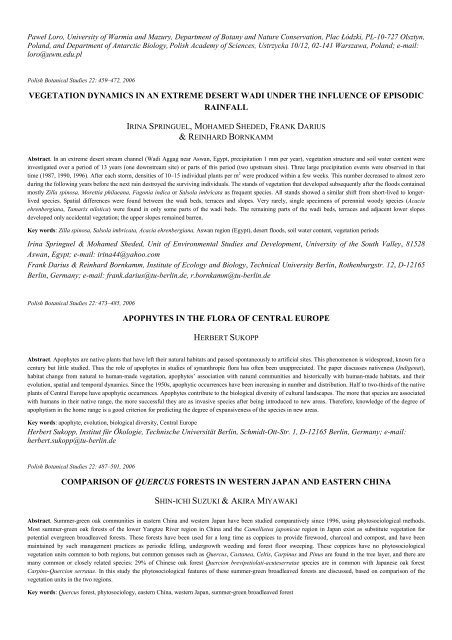Polish Botanical Studies 22 (2006)
Polish Botanical Studies 22 (2006)
Polish Botanical Studies 22 (2006)
You also want an ePaper? Increase the reach of your titles
YUMPU automatically turns print PDFs into web optimized ePapers that Google loves.
Paweł Loro, University of Warmia and Mazury, Department of Botany and Nature Conservation, Plac Łódzki, PL-10-727 Olsztyn,<br />
Poland, and Department of Antarctic Biology, <strong>Polish</strong> Academy of Sciences, Ustrzycka 10/12, 02-141 Warszawa, Poland; e-mail:<br />
loro@uwm.edu.pl<br />
<strong>Polish</strong> <strong>Botanical</strong> <strong>Studies</strong> <strong>22</strong>: 459–472, <strong>2006</strong><br />
VEGETATION DYNAMICS IN AN EXTREME DESERT WADI UNDER THE INFLUENCE OF EPISODIC<br />
RAINFALL<br />
IRINA SPRINGUEL, MOHAMED SHEDED, FRANK DARIUS<br />
& REINHARD BORNKAMM<br />
Abstract. In an extreme desert stream channel (Wadi Aggag near Aswan, Egypt, precipitation 1 mm per year), vegetation structure and soil water content were<br />
investigated over a period of 13 years (one downstream site) or parts of this period (two upstream sites). Three large precipitation events were observed in that<br />
time (1987, 1990, 1996). After each storm, densities of 10–15 individual plants per m 2 were produced within a few weeks. This number decreased to almost zero<br />
during the following years before the next rain destroyed the surviving individuals. The stands of vegetation that developed subsequently after the floods contained<br />
mostly Zilla spinosa, Morettia philaeana, Fagonia indica or Salsola imbricata as frequent species. All stands showed a similar shift from short-lived to longerlived<br />
species. Spatial differences were found between the wadi beds, terraces and slopes. Very rarely, single specimens of perennial woody species (Acacia<br />
ehrenbergiana, Tamarix nilotica) were found in only some parts of the wadi beds. The remaining parts of the wadi beds, terraces and adjacent lower slopes<br />
developed only accidental vegetation; the upper slopes remained barren.<br />
Key words: Zilla spinosa, Salsola imbricata, Acacia ehrenbergiana, Aswan region (Egypt), desert floods, soil water content, vegetation periods<br />
Irina Springuel & Mohamed Sheded, Unit of Environmental <strong>Studies</strong> and Development, University of the South Valley, 81528<br />
Aswan, Egypt; e-mail: irina44@yahoo.com<br />
Frank Darius & Reinhard Bornkamm, Institute of Ecology and Biology, Technical University Berlin, Rothenburgstr. 12, D-12165<br />
Berlin, Germany; e-mail: frank.darius@tu-berlin.de, r.bornkamm@tu-berlin.de<br />
<strong>Polish</strong> <strong>Botanical</strong> <strong>Studies</strong> <strong>22</strong>: 473–485, <strong>2006</strong><br />
APOPHYTES IN THE FLORA OF CENTRAL EUROPE<br />
HERBERT SUKOPP<br />
Abstract. Apophytes are native plants that have left their natural habitats and passed spontaneously to artificial sites. This phenomenon is widespread, known for a<br />
century but little studied. Thus the role of apophytes in studies of synanthropic flora has often been unappreciated. The paper discusses nativeness (Indigenat),<br />
habitat change from natural to human-made vegetation, apophytes’ association with natural communities and historically with human-made habitats, and their<br />
evolution, spatial and temporal dynamics. Since the 1950s, apophytic occurrences have been increasing in number and distribution. Half to two-thirds of the native<br />
plants of Central Europe have apophytic occurrences. Apophytes contribute to the biological diversity of cultural landscapes. The more that species are associated<br />
with humans in their native range, the more successful they are as invasive species after being introduced to new areas. Therefore, knowledge of the degree of<br />
apophytism in the home range is a good criterion for predicting the degree of expansiveness of the species in new areas.<br />
Key words: apophyte, evolution, biological diversity, Central Europe<br />
Herbert Sukopp, Institut für Ökologie, Technische Universität Berlin, Schmidt-Ott-Str. 1, D-12165 Berlin, Germany; e-mail:<br />
herbert.sukopp@tu-berlin.de<br />
<strong>Polish</strong> <strong>Botanical</strong> <strong>Studies</strong> <strong>22</strong>: 487–501, <strong>2006</strong><br />
COMPARISON OF QUERCUS FORESTS IN WESTERN JAPAN AND EASTERN CHINA<br />
SHIN-ICHI SUZUKI & AKIRA MIYAWAKI<br />
Abstract. Summer-green oak communities in eastern China and western Japan have been studied comparatively since 1996, using phytosociological methods.<br />
Most summer-green oak forests of the lower Yangtze River region in China and the Camellietea japonicae region in Japan exist as substitute vegetation for<br />
potential evergreen broadleaved forests. These forests have been used for a long time as coppices to provide firewood, charcoal and compost, and have been<br />
maintained by such management practices as periodic felling, undergrowth weeding and forest floor sweeping. These coppices have no phytosociological<br />
vegetation units common to both regions, but common genuses such as Quercus, Castanea, Celtis, Carpinus and Pinus are found in the tree layer, and there are<br />
many common or closely related species: 29% of Chinese oak forest Quercion brevipetiolati-acuteserratae species are in common with Japanese oak forest<br />
Carpino-Quercion serratae. In this study the phytosociological features of these summer-green broadleaved forests are discussed, based on comparison of the<br />
vegetation units in the two regions.<br />
Key words: Quercus forest, phytosociology, eastern China, western Japan, summer-green broadleaved forest
















